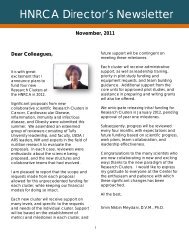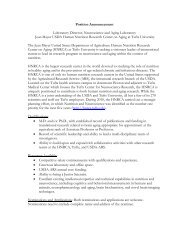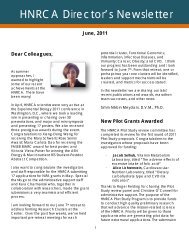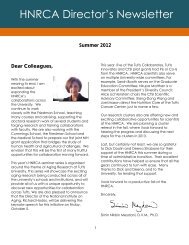Microbiome - Human Nutrition Research Center on Aging - Tufts ...
Microbiome - Human Nutrition Research Center on Aging - Tufts ...
Microbiome - Human Nutrition Research Center on Aging - Tufts ...
You also want an ePaper? Increase the reach of your titles
YUMPU automatically turns print PDFs into web optimized ePapers that Google loves.
A TALE OF KALE<br />
Produce, with all the intimate details<br />
The “know-your-farmer” movement has<br />
acquainted many c<strong>on</strong>sumers with the origins<br />
of the foods they buy. Could “know your<br />
biochemist” be the next step? Talk and<br />
Taste, a new series at the Jean Mayer USDA<br />
<str<strong>on</strong>g>Human</str<strong>on</strong>g> <str<strong>on</strong>g>Nutriti<strong>on</strong></str<strong>on</strong>g> <str<strong>on</strong>g>Research</str<strong>on</strong>g> <str<strong>on</strong>g>Center</str<strong>on</strong>g> <strong>on</strong> <strong>Aging</strong><br />
(HNRCA), aims to get you even more familiar<br />
with your favorite fruits and vegetables, right<br />
down to the molecular level.<br />
About 70 people gathered this spring<br />
to learn all about kale—from what soils<br />
are ideal for seedlings, to its biochemical<br />
properties, to how best to cook it to bring out<br />
its nutrients and flavor. Sarah Booth, director<br />
of the HNRCA’s Vitamin K Laboratory,<br />
explained the nutriti<strong>on</strong>al benefits of kale,<br />
which is heavy in vitamin K, and the role it<br />
plays in blood coagulati<strong>on</strong>. Betty Sanders,<br />
master gardener from the Massachusetts<br />
Horticultural Society, talked about best<br />
practices for growing kale in New England.<br />
Chef Rolando Robledo of Clover FoodLab provided<br />
a cooking dem<strong>on</strong>strati<strong>on</strong> and tasting of<br />
his white bean, butternut and kale soup.<br />
The series, which has also delved into<br />
pumpkin and strawberries, is a partnership<br />
between the HNRCA and the Massachusetts<br />
Horticultural Society. For more informati<strong>on</strong>,<br />
visit hnrca.tufts.edu/events/talk-and-taste.<br />
Before the Well Runs Dry<br />
With the world populati<strong>on</strong> expected to hit 9<br />
billi<strong>on</strong> by 2050, some predict food producti<strong>on</strong><br />
will need to almost double to feed them. Now<br />
c<strong>on</strong>sider that agriculture accounts for 70 to 80<br />
percent of global water use. The questi<strong>on</strong> quickly becomes: Will<br />
there be enough water to go around?<br />
The c<strong>on</strong>sensus at a symposium sp<strong>on</strong>sored<br />
by the <strong>Tufts</strong> interdisciplinary graduate<br />
program Water: Systems, Science and<br />
Society, aptly titled “Feeding Ourselves<br />
Thirsty,” was a str<strong>on</strong>g…maybe.<br />
On the bright side, Timothy Wise,<br />
G05, director of the research and policy<br />
program at the Global Development and<br />
Envir<strong>on</strong>ment Institute at <strong>Tufts</strong>, said that<br />
studies dem<strong>on</strong>strate ways in which we<br />
could increase crop yields by 50 percent,<br />
with just a 13-percent increase in water<br />
use. But that is assuming that farmers<br />
employ smart water-use techniques, which<br />
is far from the case worldwide.<br />
In Mexico, for example, water use is<br />
twice what it should be because of outdated<br />
irrigati<strong>on</strong> systems.<br />
Brazil and Australia have already put<br />
m<strong>on</strong>ey toward more efficient use of the natural<br />
resource. Indeed, agriculture in south-<br />
Water tank with solar panels<br />
eastern Australia survived an eight-year drought, which had robbed<br />
it of 70 percent of its available water, by instituting such efficiencies.<br />
Danielle Nierenberg, N01, cofounder of the policy institute<br />
FoodTank, argued that promoting such inexpensive, local and<br />
culturally appropriate soluti<strong>on</strong>s as rainwater harvesting and solarpowered<br />
irrigati<strong>on</strong>—steps she has seen African farmers already taking—could<br />
have a much bigger effect than a<br />
costly search for a magic-bullet technology.<br />
“There are countless examples of hope<br />
and success and innovati<strong>on</strong> going <strong>on</strong>”<br />
around the globe, she said.<br />
Roberto Lent<strong>on</strong>, Ph.D., the founding<br />
executive director of the Robert B.<br />
Daugherty Water for Food Institute at the<br />
University of Nebraska, said he is inspired<br />
by farmers in western India, who use their<br />
cell ph<strong>on</strong>es to activate electr<strong>on</strong>ic irrigati<strong>on</strong><br />
pumps, and pastoralists in Kenya, who<br />
upload info <strong>on</strong> groundwater c<strong>on</strong>diti<strong>on</strong>s<br />
to the Internet to form a real-time map of<br />
water availability.<br />
Good water practices can also come<br />
from unexpected corners. Satellite images<br />
have revealed that Taliban-c<strong>on</strong>trolled<br />
regi<strong>on</strong>s of Afghanistan employ drip irrigati<strong>on</strong>,<br />
which saves <strong>on</strong> water and fertilizer, <strong>on</strong><br />
their poppy farms.<br />
PHOTOS: ISTOCKPHOTO<br />
summer 2013 tufts nutriti<strong>on</strong> 27







